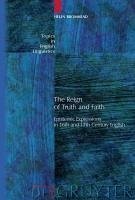The book explores the semantics and pragmatics of epistemic expressions in 16th and 17th century English: verily, in faith, I ween and others. Using the Natural Semantic Metalanguage (NSM) approach, evidence from texts and collocations, and adducing cultural evidence, the work argues for the existence of a distinct epistemic ethos in 16th and 17th centuryways of thinking and speaking, an ethos of truth, faith, and certainty.
Dieser Download kann aus rechtlichen Gründen nur mit Rechnungsadresse in A, B, BG, CY, CZ, D, DK, EW, E, FIN, F, GR, HR, H, IRL, I, LT, L, LR, M, NL, PL, P, R, S, SLO, SK ausgeliefert werden.


